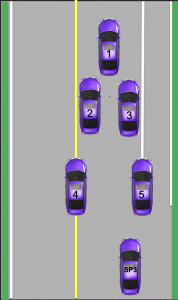Lesson Two: Lane Positions (2.2)
Lane positions help you accurately position your vehicle in different locations on the roadway and communicate your intentions to other roadway users. There are five lane positions and two side positions, one side position is used for parking only. Selecting the best lane position requires you to identify your target and vehicle path. Then, place your vehicle in the correct lane position to manage risk and communicate your intentions to others.

Lane Position 1
Center of your lane. Used for most driving situations. It gives you space to make adjustments to the left or right if necessary. If lane position 1 is your only option, you must reduce speed.
Lane Position 2
3-6 inches from the left side (line, center line or curb). Used for creating space to the right or preparing for a left turn. Cannot be used if there is oncoming traffic.
Lane Position 3
3-6 inches from the right side (fog line/bike lane). Used for creating space to the left or preparing to turn right.
Lane Position 4
Straddling line to the left. Used for creating more space to the right, i.e. bicycles, pedestrians, lane changes, disabled vehicles, etc.
Lane Position 5
Straddling line to the right. Used for creating more space to the left, i.e. debris in the roadway, crash, disabled vehicle, etc.
Side Position 3
3 feet from the right side (curb or edge of road). Used for turning right when a curb is present but no bike lane or for approaching parallel parking.
 Lane Position Selection
Lane Position Selection
Essential Question
-
Identify different situations where each lane position would be appropriate.
The position of your vehicle within a lane.